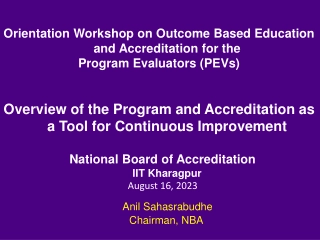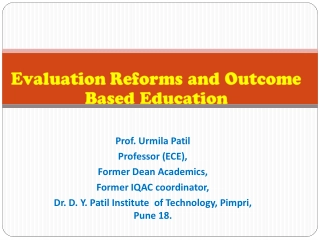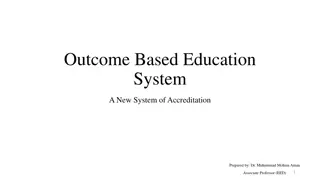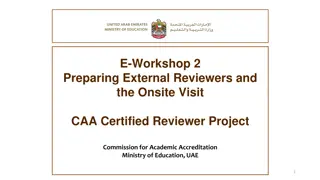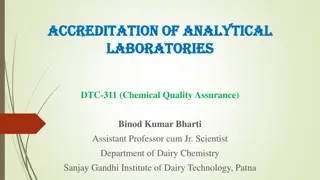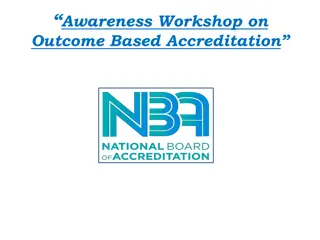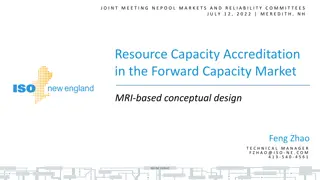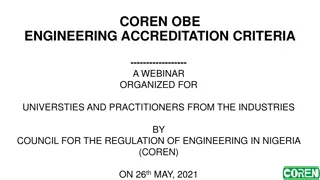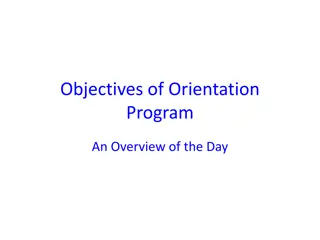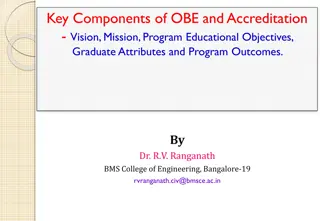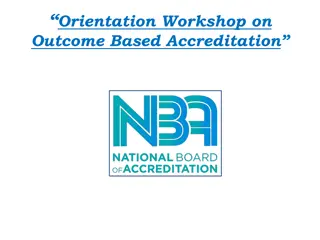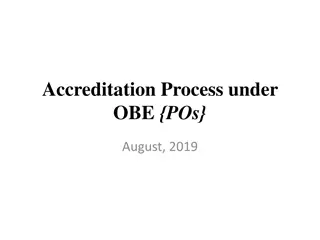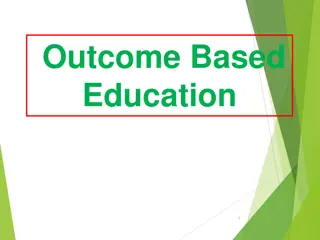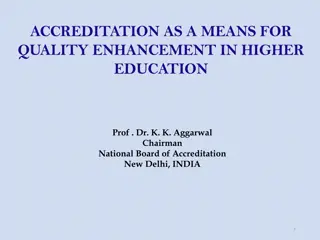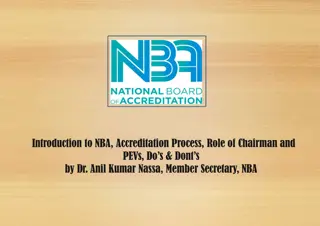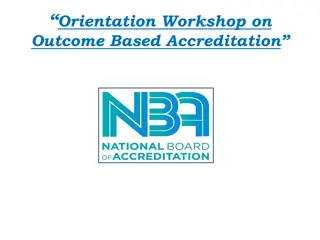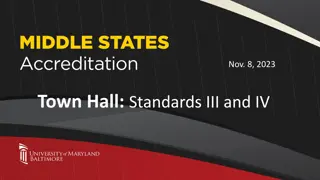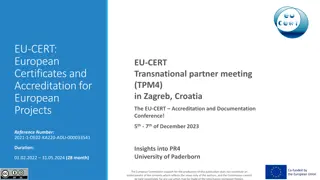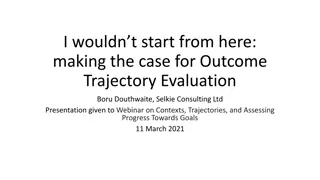Understanding Outcome-Based Education (OBE) and Accreditation for Program Evaluators Workshop
Explore the framework of OBE and accreditation, focusing on defining program outcomes, assessing outcomes, and continuous improvement through evaluation guidelines and reports. Learn about quality improvement in education through curriculum design and attainment analysis. Discover how to measure student achievement and alignment with course outcomes. Expectations and assessments are crucial aspects for improvement in educational standards.
Download Presentation

Please find below an Image/Link to download the presentation.
The content on the website is provided AS IS for your information and personal use only. It may not be sold, licensed, or shared on other websites without obtaining consent from the author. Download presentation by click this link. If you encounter any issues during the download, it is possible that the publisher has removed the file from their server.
E N D
Presentation Transcript
WELCOME Orientation Workshop on Outcome Orientation Workshop on Outcome- -Based Education (OBE) and Accreditation Based Education (OBE) and Accreditation OBE&A for Program Evaluators (PEVs) OBE&A for Program Evaluators (PEVs) PEOs, Curriculum and Teaching Learning, Analysis and Attainment of COs & POs 11:30 13:00, 11 August 2023 VJTI Mumbai Prof C R MUTHUKRISHNAN 1
NBA documents for PEVs 1. 1. SAR SAR Self Assessment Report Self Assessment Report 2. 2. Evaluation Guidelines Evaluation Guidelines 3. 3. PE report PE report PART PART- -A A 4. 4. PE report PE report PART PART- -B B 5. 5. Previsit Report Previsit Report 2
About OBE OBE is a quality improvement framework/system What do we want our students to achieve? What do we want our students to achieve? Captured in PROGRAM OUTCOMES [POs] Captured in PROGRAM OUTCOMES [POs] How do our students achieve it? How do our students achieve it? Through curriculum comprising courses with Course Outcomes Through curriculum comprising courses with Course Outcomes [COs], teaching/learning and evaluation [COs], teaching/learning and evaluation How do we know how well our students have achieved it? How do we know how well our students have achieved it? Assess attainment of COs and POs Assess attainment of COs and POs How do we close the loop for further improvement How do we close the loop for further improvement (Continuous Quality Improvement (CQI) Improvement (CQI)? ? Make use of the assessment of attainment of COs and POs Make use of the assessment of attainment of COs and POs (Continuous Quality 3
What is Quality Quality Quality stating what is to be achieved POs , COs and PO stating what is to be achieved POs , COs and PO steps (actions) to do to achieve it T- -L L- -A A course feedback and improvement Measuring the COs *Assessment of Attainment of COs [3] *Assessment of Attainment of COs [3] Analyse Attainment and & take up improvements [7] CO mapping [3] CO mapping [3] constructive alignment [2] constructive alignment steps (actions) to do to achieve it T [2] In In- -course feedback and improvement Measuring the COs Analyse Attainment and & take up improvements [7] *If expectations are set high *If expectations are set high assessment may be low. assessment may be low. If expectations are set low If expectations are set low assessments may be high Expectations to be set appropriately Expectations to be set appropriately assessments may be high 4
OBE overview/model MEASUREMENT METHODS; OUTCOME ASSESSMENT CRITERIA (3) VISION(1) MISSION (1) POs/PSOs and COs T-L-A(2&3) RESULTS -->ANALYSIS (3,7) PEOs (1) IDENTIFY ACTION ; IMPLEMENT (7) 5
What is an OUTCOME? Course Outcomes Outcomes state state what course course and and earning earning a a pass perform/do/demonstrate perform/do/demonstrate with These These are are also also referred referred as as Learning and and in in NBA NBA we we use use the emphasis emphasis on on use/application use/application of of the successful successful student student in in the the course The central concept in OBE is OUTCOMES The central concept in OBE is OUTCOMES We have We have course outcomes course outcomes(COs) and Course what a a student, student, on pass grade grade and with what what he/she Learning Outcomes the term term Course Course Outcomes the knowledge knowledge imparted/acquired course and and not not on on the the knowledge on successfully successfully completing and the the credit credit is is competent he/she has has learnt learnt in in the Outcomes or or Student Student Outcomes Outcomes (COs) imparted/acquired by knowledge per completing the competent to to the course Outcomes (COs). . Note Note the the course. . the by a a per se se. . (COs) and Program outcomes Program outcomes(POs) (POs) 6
PEO Example Aeronautical Engineering PEO PEO1 1. . government, government, academia Our Our graduates graduates will academia and will have and military military as as innovative have successful successful professional innovative engineers professional careers engineers. . careers in in industry, industry, PEO PEO2 2. . Our with with the the lifecycle Our graduates graduates will lifecycle of of aircraft will be aircraft systems systems be successful successful in in solving solving engineering engineering problems problems associated associated PEO PEO3 3. . Our activities activities such professional professional certification Our graduates graduates will such as as participation certification and will continue continue to to learn participation in in professional and seeking seeking higher learn and professional organizations, higher education education. . and advance advance their organizations, attainment their careers careers through attainment of of through PEO PEO4 4. . Our internationally internationally Our graduates graduates will will be be active active members members ready ready to to serve serve the the society society locally locally and and Note Note that that PEOs PEOs are are about about what what graduates graduates may may do do after after they they graduate graduate 7
Programme Educatioanl Objectives (PEO): (Mechanical) To develop technically competent mechanical engineers well-trained in basic principles so that they are able to adapt to technological advancement. To produce broad-minded mechanical engineers who are able to manage well in technology as well as in human relations. 8
Programme Educatioanl Objectives (PEO): (Telecommunications) To produce all-rounded engineers in the telecommunications technologies in support of the emerging ICT industry. To develop capable technical leaders who are able to spearhead the advancement of telecommunications in the country 9
Programme Educational Objectives (PEO): (Bio-Instrumentation) To produce engineers of high caliber who will lead, facilitate and support the development of biotechnology, health, and life sciences industries. To spearhead and enhance the efficiency of wealth creation via the biotechnology, health, and life sciences industries.. 10
Criteria Summary Name of the program: Criteria No. Criteria Marks Program Level Criteria 1. Vision, Mission and Program Educational Objectives 50 2. Program Curriculum and Teaching Learning Processes 100 3. Course Outcomes and Program Outcomes 175 4. Students Performance 100 5. Faculty Information and Contributions 200 6. Facilities and Technical Support 80 75 7. Continuous Improvement Institute Level Criteria 8. First Year Academics 50 9. Student Support Systems 50 10. Governance, Institutional Support and Financial Resources 120 Total 400+280+220 1000 11
ANNEXURE I (A) PROGRAM OUTCOMES Engineering Graduates will be able to: 1. Engineering knowledge: Apply the knowledge of mathematics, science, engineering fundamentals, and an engineering specialization to the solution of complex engineering problems. 2. Problem analysis: Identify, formulate, review research literature, and analyze complex engineering problems reaching substantiated conclusions using first principles of mathematics, natural sciences, and engineering sciences. 3. Design/development of solutions: Design solutions for complex engineering problems and design system components or processes that meet the specified needs with appropriate consideration for the public health and safety, and the cultural, societal, and environmental considerations. 4. Conduct investigations of complex problems: Use research-based knowledge and research methods including design of experiments, analysis and interpretation of data, and synthesis of the information to provide valid conclusions. 5. Modern tool usage: Create, select, and apply appropriate techniques, resources, and modern engineering and IT tools including prediction and modeling to complex engineering activities with an understanding of the limitations. 12
6. The engineer and society: Apply reasoning informed by the contextual knowledge to assess societal, health, safety, legal and cultural issues and the consequent responsibilities relevant to the professional engineering practice. 7. Environment and sustainability: Understand the impact of the professional engineering solutions in societal and environmental contexts, and demonstrate the knowledge of, and need for sustainable development. 8. Ethics: Apply ethical principles and commit to professional ethics and responsibilities and norms of the engineering practice. 9. Individual and team work: Function effectively as an individual, and as a member or leader in diverse teams, and in multidisciplinary settings. 10. Communication: Communicate effectively on complex engineering activities with the engineering community and with society at large, such as, being able to comprehend and write effective reports and design documentation, make effective presentations, and give and receive clear instructions. 11. Project management and finance: Demonstrate knowledge and understanding of the engineering and management principles and apply these to one s own work, as a member and leader in a team, to manage projects and in multidisciplinary environments. 12. Life-long learning: Recognize the need for, and have the preparation and ability to engage in independent and life-long learning in the broadest context of technological change. 13
PSOs Example (Civil Engineering) PSO1: Proficiency in a specialized area: Demonstrate proficiency in one of the following specialized areas of Civil Engineering i) Construction Materials and Management ii) Structural and Geotechnical Engineering iii) Environmental, water resources and Transportation Engineering PSO2: Ability to apply principles of civil engineering for the entire life cycle of the project ranging from initial design to the closure of the project. PSO3: Ability to identify and analyse various properties of construction materials and their applications in design and construction of various structures 14
About complexity (Complex Problems) Non Non- -linearity linearity Dynamic equilibrium Dynamic equilibrium Operating range and characteristics/behaviour outside the OR Operating range and characteristics/behaviour outside the OR Reliability/ fault Reliability/ fault- -tolerance and recovery tolerance and recovery Transients/Time variance/ dynamic versus static Transients/Time variance/ dynamic versus static Size/Scale Size/Scale Elemental versus System Complexity Elemental versus System Complexity Life Life- -cycle issues for processes and products cycle issues for processes and products Evolution Evolution Maintainability, Serviceability (RAS) Maintainability, Serviceability (RAS) Systems as Interconnection of parts or subsystems and interactions Systems as Interconnection of parts or subsystems and interactions Functional and Non Functional and Non- -functional specifications and partial specifications functional specifications and partial specifications Open Open- -endedness/in endedness/in- -completeness completeness Have more than one (many) solutions Have more than one (many) solutions Simple Simple- -complex is not binary; it is multidimensional continuum complex is not binary; it is multidimensional continuum Essence captured in HOTS - - higher higher- -order thinking skills order thinking skills (BLOOMS TAXONOMY) Essence captured in HOTS (BLOOMS TAXONOMY) 15
Some characteristics of complex engineering problems 1. 1. It must require the application of in depth knowledge, and additionally It must require the application of in depth knowledge, and additionally It must satisfy at least one of the following additional characteristics: It must satisfy at least one of the following additional characteristics: 2. 2. I Involves wide ranging or conflicting issues nvolves wide ranging or conflicting issues 3. 3. H Has no obvious solution such that creativity/originality/innovation is required as no obvious solution such that creativity/originality/innovation is required 4. 4. I Involves infrequently encountered issues nvolves infrequently encountered issues 5. 5. May be May be outside accepted standards and codes outside accepted standards and codes 6. 6. I Involves nvolves interaction with interaction with diverse stakeholders and their needs diverse stakeholders and their needs 7. 7. P Posed osed at a high level with many components or sub problems that requires a at a high level with many components or sub problems that requires a systems approach systems approach 16
Assessment of attainment of Outcomes COs, POs OUTCOMES are what our students achieve by T-L-A We need to measure to what extent the outcomes are attained and, use the measurement to identify doable improvements and act on these. CO attainment are to be calculated by the teacher at the end of the course POs are to be assessed at the end of the program, that is, every year for the graduating batch may also be assessed in between (partial) for possible in- program improvement. Since POs are achieved by COs, PO assessment will use CO assessment as input and be based on CO-PO matrix which captures the contribution of COs to POs CO assessment will be based on how students do in the tests/quizzes, internal/end-semester examinations, assignments/home-work and therefore, we need to capture connection between questions in the exam/test and the COs These assessments are for an entire class (i.e., aggregate) as distinct from individual student performance 17
Example of Course Outcomes COs Course Title: Heat & Mass Transfer Course Title: Heat & Mass Transfer CO1 CO1 Solve practical engineering problems using basic concepts of heat and mass transfer. practical engineering problems using basic concepts of heat and mass transfer. CO2 CO2 Evaluate steady and unsteady performance for insulation, fin and thermocouple. steady and unsteady performance for insulation, fin and thermocouple. CO3 CO3 Analyze laminar and turbulent boundary layer flow on internal and external regions. laminar and turbulent boundary layer flow on internal and external regions. CO4. CO4. Design shell and tube type heat exchangers for convective heat transfer applications. shell and tube type heat exchangers for convective heat transfer applications. CO5 CO5 Analyze phase change heat transfer processes applied to process phase change heat transfer processes applied to process- -heat applications heat applications CO6 CO6 Determine radiation heat transfer rates in engineering problems. radiation heat transfer rates in engineering problems. CO7 CO7 Perform design calculations design calculations for a for a thermal equipment and prepare technical report thermal equipment and prepare technical report 18
CO-PO mapping (connecting COs with POs) The mapping is a matrix with rows as COs and columns as POs Each cell in the matrix has a value in {--, 1, 2, 3} The meaning associated with the values are as follows: -- this CO (row) has negligible contribution to the PO(column) 1 relevant and small significance 2 medium or moderate and 3 strong These values have to be justified in implementation, that is, T-L-A of the course, in terms of the BLOOM Level of the questions/Problems 19
An Example CO-PO mapping (contd ..) PO1 PO1 PO2 PO2 PO3 PO3 PO4 PO4 CO1 CO1 2 2 2 2 CO2 CO2 3 3 CO3 CO3 2 2 2 2 CO4 CO4 3 3 2 2 CO5 CO5 3 3 CO6 CO6 2 2 CO7 CO7 3 3 3 3 20
Course : Data Structures and Algorithms PO1 PO2 PO3 PO4 PO5 CO1 CO1 : : Apply concepts of List ADT in linear and non Apply concepts of List ADT in linear and non- -linear data structures linear data structures Mapping & Mapping & Justification Justification 2 2 2 2 3 3 solutions solutions using using List ADT ADT - - implement implement and analyse and analyse 1 1 2 2 Basic Basic concepts of concepts of Data Data structures structures introduced introduced Problem Problems s for which for which Lists are Lists are used will be used will be discussed discussed Use of Use of List ADT in List ADT in various various requirements will be requirements will be evaluated evaluated Programs to Programs to implement solutions implement solutions will be taught will be taught List CO2: CO2: Implement stacks and queues in applications Implement stacks and queues in applications 1 1 Fundamenta Fundamenta ls ls of stacks of stacks and queues and queues will be will be discussed discussed 2 2 Problem Problem analysis analysis to use stacks use stacks and queues and queues 3 3 1 1 2 2 Implementati Implementati on of on of solutions solutions u using stacks sing stacks and queues and queues for various for various problems problems Applications Applications of Stacks and of Stacks and queues queues evaluated evaluated Programming Programming implementations implementations of solutions of solutions to 21
PO1 PO2 PO3 PO4 PO5 PO6 PO7 PO8 PO9 CO3: CO3: Analyse Analyse and use concepts of tree data structure and use concepts of tree data structure 1 1 2 2 3 3 1 1 2 2 Fundamental Fundamental concepts of concepts of Trees will be Trees will be discussed discussed problems problems for which trees which trees can be used can be used will be will be discussed discussed for Development Development of s of solutions olutions using using Trees will Trees will be be implemented implemented and analysed and analysed Use of Use of Trees for various for various applications applications will be will be evaluated evaluated Trees Programs to Programs to implement implement solutions solutions will be taught will be taught CO4: CO4: Implement Implement graph for problem solving graph for problem solving 1 1 3 3 3 3 1 1 2 2 Fundamental Fundamental concepts of concepts of Graphs will be Graphs will be discussed discussed Problem Problem modeling modeling using using Graphs Graphs and and solutions solutions will will be be developed developed Solutions Solutions using using Graphs Graphs will be will be analysed analysed Usage of Usage of Graphs in Graphs in various various domains domains will be will be evaluated evaluated Programming Programming language to language to implement implement solutions will be solutions will be taught taught : 22
PO1 PO1 PO2 PO2 PO3 PO3 PO4 PO4 PO5 PO5 CO5: CO5: Analyse Analyse and apply appropriate searching and sorting techniques in real world contexts and apply appropriate searching and sorting techniques in real world contexts 1 1 2 2 3 3 Solutions Solutions using using various various sorting and sorting and searching searching algorithms algorithms Wii be Wii be implemented implemented 3 3 2 2 Fundamental Fundamental concepts of concepts of Sorting and Sorting and Searching Searching will be will be discussed discussed applications applications of Sorting of Sorting and and searching searching algorithms algorithms will be will be discussed discussed different different algorithms algorithms and their and their efficiency efficiency will be will be evaluated evaluated and and compared compared Programs Programs for for algorithms algorithms will be will be worked worked out out 23
Engineering Mathematics I CO1: Solve first order ordinary differential equations using methods to calculate integrals CO2: Model physical processes such as Newton s law of cooling, electrical circuit, rectilinear motion, mass spring systems using mathematics (ordinary linear differential equations) CO3: Trace the curve for a given equation and measure arc length of various curves. CO4: Simple solid geometry using equations of sphere, cone and cylinder with problems CO5: Evaluate multiple integrals and apply to find area bounded by curves, volume bounded by surfaces, Centre of gravity and Moment of inertia. 24
CO1: Mean value theorems and its generalizations leading to Taylors and Maclaurin s series and application in the analysis of engineering problems. CO2: Fourier series representation and harmonic analysis and analysis of periodic continuous systems. CO3: Derivative of functions of several variables and applications in Engineering. CO4: Matrices and linear algebra and analysis of system of linear equations, finding linear and orthogonal transformations with problems from Engineering. Engineering Mathematics II 25
Engineering Physics CO1: Interference, diffraction & polarization; applications in engineering. CO2: Lasers & optical fibres & their use in some industrial applications. CO3: Theory of semiconductors & their applications in some semiconductor devices. CO4: Basics of magnetism & superconductivity; applications in Engineering. CO6: Nanomaterials & their applications. 26
Engineering Chemistry CO1: Methods and techniques for analysis of water and applications in softening/reuse of water . CO2: On completion of course, learner will be able to select appropriate electro-technique and method of material analysis. CO3: Demonstrate the knowledge of advanced engineering materials for various engineering applications. CO4: On completion of course, learner will be able to, Analyse fuel and suggest use of alternative fuels. CO5: On completion of course, learner will be able to identify chemical compound based on their structure. CO6: On completion of course, learner will be able to, explain causes of corrosion and methods of minimizing corrosion. 27
Basic Electrical Engineering CO1: Differentiate between electrical and magnetic circuits and derive mathematical relation for self and mutual inductance along with coupling effect. CO2: Calculate series, parallel and composite capacitor as well as characteristic parameters of alternating quantity and phasor arithmetic. CO3: Derive expression for impedance, current, power in series and parallel RLC circuit with AC supply along with phasor diagram. CO4: Relate phase and line electrical quantities in polyphase networks, demonstrate the operation of single-phase transformer and calculate efficiency and regulation at different loading conditions. CO5: Apply and analyse the resistive circuits using star-delta conversion KVL, KCL and different network theorems under DC supply. CO6: Evaluate work, power, energy relations and suggest various batteries for different applications, concept of charging and discharging and depth of charge. 28
Basic Electronics Engineering CO1: Explain the working of P-N junction diode and its circuits. CO2: Identify types of diodes and plot their characteristics; compare BJT with MOSFET. CO3: Build and test analog circuits using OPAMP and digital circuits using universal/basic gates and flip flops. CO4: Use different electronic measuring instruments to measure various electrical parameters. CO5: Select sensors for specific applications. CO6: Describe basic principles of communication systems. 29
CO1: Draw fundamental engineering objects using basic principles and rules CO2: Construct the various engineering curves using the drawing instruments. CO3: Apply the concept of orthographic projection of an object to draw several 2D views and its sectional views for visualizing the physical state of the object. CO4: Apply the visualization skill to draw a simple isometric projection from given orthographic views precisely using drawing equipment or software. CO5: Draw the development of lateral surfaces for cut section of geometric solids. CO6: Draw fully-dimensioned 2D, 3D drawings using computer aided drafting tools. Engineering Graphics 30
Programming And Problem Solving CO1: Identify and define problem solving aspect and various data types and its operations. (Knowledge). CO2: Describe and Implement various logical constructs of Python Language. (Understand, Apply). CO3: Apply built-in functions to optimize code. (Apply) CO4: Analyse and improve programs CO5: Understand & Compare object-oriented concepts with other programming paradigms. (Evaluate) CO6: Design and Develop efficient model using Python. (Create) 31
Engineering Mechanics CO1: Determine resultant of various force systems. CO2: Determine centroid, moment of inertia CO3: calculate forces in cables using principles of equilibrium. CO4: Solve trusses, frames for finding member forces and apply principles of equilibrium to forces in space. CO6: Calculate position, velocity and acceleration of particles using principles of kinetics and Work, Power, Energy. 32
Workshop Practice CO1: Familiar with safety norms to prevent any mishap in workshop. CO2: Handle appropriate hand tool, cutting tool and machine tools to fabricate a job. CO3: Understand the construction, working and functions of machine tools and their parts. CO4: Know simple operations (Turning and Facing) on a centre lathe. 33
Project Based Learning CO1: Identify real-life-like problems by exploring sources; focus on societal needs. CO2: Analyse the identified problem in technology perspective design, improvement CO3: Propose suitable solution using knowledge of engineering and modern tools. CO4: Demonstrate solution and present in written/Oral form. CO5: Develop ability to work as an individual and as a team member. CO6: Inculcate attitude of individual and team work for lifelong learning. 34
CO1: Describe and compare the conversion of energy from renewable and non-renewable energy sources. CO2: Explain basic laws of thermodynamics, heat transfer and their applications. CO3: List the types of road vehicles and their specifications. CO4: Illustrate various basic parts and transmission system of a road(surface) vehicle. CO5: Discuss several manufacturing processes and identify their suitability for requirements. CO6: Study various types of mechanisms and their application. Systems In Mechanical Engineering 35
Writing COs Blooms Taxonomy levels connects to learning required to answer questions in Exams. Bloom's Taxonomy is widely used in education to take students beyond simple memorization. 1. Knowledge/remembering (recall) 2. Comprehension/understanding. 3. Application/applying. 4. Analysis/analyzing. 5. Evaluation/evaluating. 6. Synthesis/creating. Attaining POs requires reaching level 6 in assessment in the curriculum 36
Two useful study resources EXAMINATION REFORM POLICY, NOVEMBER 2018 https://www.aicte-india.org/sites/default/files/ExaminationReforms.pdf Model Question Papers for Undergraduate Programs Model Question Papers for Undergraduate Programs https://www.aicte https://www.aicte- -india.org/sites/default/files/MQP.pdf india.org/sites/default/files/MQP.pdf 37
Revised Blooms Taxonomy Bloom s taxonomy is hierarchical; learning at higher level requires skills at a lower level to be attained 39
Action Verbs for Assessment Choice of action verbs in constructing assessment questions is important to consider. Quite often, the action verbs are indicators of the complexity (level) of the question. Over time, educators have come up with a taxonomy of measurable verbs corresponding to each of the Bloom s cognitive levels. These verbs help us not only to describe and classify observable knowledge, skills and abilities but also to frame the examination or assignment questions that are appropriate to the level we are trying to assess. Suggestive list of skills/ competencies to be demonstrated at each of the Bloom s level and corresponding cues/ verbs for the examination/ test questions is given below: Level Skill Demonstrated Question cues / Verbs for tests 1. Remember Ability to recall facts, conventions, definitions, jargon, list, define, tell, describe, recite, recall, technical terms, classifications, categories, and criteria identify, show, label, tabulate, quote, name, ability to recall methodology and procedures, abstractions, who, when, where principles, and theories in the field knowledge of dates, events, places mastery of subject matter 40
Level Skill Demonstrated Question cues / Verbs for tests describe, explain, paraphrase, restate, 2. Understand understanding information grasp meaning associate, contrast, summarize, differentiate translate knowledge into new context interpret, discuss interpret facts, compare, contrast order, group, infer causes predict consequences 3. Apply use information calculate, predict, apply, solve, illustrate, use, use methods, concepts, laws, theories in new demonstrate, determine, model, experiment, situations show, examine, modify solve problems using required skills or knowledge Demonstrating correct usage of a method or procedure 4. Analyse break down a complex problem into parts classify, outline, break down, categorize, Identify the relationships and interaction between the analyze, diagram, illustrate, infer, select different parts of a complex problem identify the missing information, sometimes the redundant information and the contradictory information, if any 41 Examination Reform Policy
Level Skill Demonstrated Question cues / Verbs for tests assess, decide, choose, rank, grade, 5. Evaluate compare and discriminate between ideas assess value of theories, presentations test, measure, defend, recommend, make choices based on reasoned argument convince, select, judge, support, verify value of evidence conclude, argue, justify, compare, recognize subjectivity summarize, evaluate use of definite criteria for judgments use old ideas to create new ones 6. Create design, formulate, build, invent, create, Combine parts to make (new) whole, compose, generate, derive, modify, generalize from given facts develop, integrate relate knowledge from several areas predict, draw conclusions It may be noted that some of the verbs in the above table are associated with multiple Bloom s Taxonomy levels. These verbs are actions that could apply to different activities. We need to keep in mind that it is the skill, action or activity we need students to demonstrate that will determine the contextual meaning of the verb used in the assessment question. 42 Examination Reformolicy
. Assessment Planning Normally the first three learning levels; remembering, understanding and applying and to some extent fourth level analysing are assessed in the Continuous Internal Evaluation (CIE) and Semester End Examinations (SEE), where students are given a limited amount of time. And abilities; analysis, evaluation and creation can be assessed in extended course works or in a variety of student works like course projects, mini/ minor projects, internship experience and final year projects. 43 Examination Reform Policy
APPENDIX APPENDIX- -A A Competencies and Performance Indicators (PIs) Computer Science & Engineering/Information Technology Programs PO 1: Engineering knowledge: Apply the knowledge of mathematics, science, engineering fundamentals, and an engineering specialisation for the solution of complex engineering problems. Competency Indicators 1.2.1 1.2 Demonstrate competence in mathematical modelling Apply the knowledge of discrete structures, linear algebra, statistics and numerical techniques to solve problems Apply the concepts of probability, statistics and queuing theory in modeling of computer-based system, data and network protocols. 1.2.2 1.5 Demonstrate competence in basic sciences 1.5.1 Apply laws of natural science to an engineering problem 44 Appendix
APPENDIX APPENDIX- -B B Sample questions for Bloom s Taxonomy levels Sample questions for Bloom s Taxonomy levels SAMPLES QUESTIONS FOR BLOOMS TAXONOMY LEVELS: 1. REMEMBER Skill Demonstrated Question Ques / Verbs for tests Ability to recall of information like, facts, conventions, list, define, describe, state, recite, recall, identify, show, definitions, jargon, technical terms, classifications, label,tabulate, quote, name, who, when, where, etc. categories, and criteria ability to recall methodology and procedures, abstractions, principles, and theories in the field knowledge of dates, events, places mastery of subject matter 46 Appendix
Sample Questions: State Ohm s law 1. List the physical and chemical properties of silicon 2. List the components of A/D converter 3. List the arithmetic operators available in C in increasing order of precedence. 4. Define the purpose of a constructor. 5. Define the terms: Sensible heat, Latent heat and Total heat of evaporation 6. List the assembler directives. 7. Describe the process of galvanisation and tinning 8. 47 Appendix
Sample Questions: 9. Write truth table and symbol of AND, OR, NOT, XNOR gates 10. Define the terms: Stress, Working stress and Factor of safety. 11. What is the difference between declaration and definition of a variable/function? 12. List the different storage class specifiers in C. 13. What is the use of local variables? 14. What is a pointer to a pointer? 15. What are the valid places for the keyword break to appear? 16. What is a self-referential structure? 48
2. UNDERSTAND Skill Demonstrated Question Ques / Verbs for tests understanding information describe, explain, paraphrase, restate, associate, contrast, grasp meaning summarize, differentiate interpret, discuss translate knowledge into new context interpret facts, compare, contrast order, group, infer causes predict consequences Sample Questions: 1. Explain the importance of sustainability in Engineering design 2. Explain the behaviour of PN junction diode under different bias conditions 3. Describe the characteristics of SCR and transistor equivalent for a SCR 4. Explain the terms: Particle, Rigid body and Deformable body giving two examples for each. 49
Sample Questions: 5. How many values of the variable num must be used to completely test all branches of the following code fragment? if (num>0) if (value<25) { value=10*num; if(num<12) value=value/10; } else Value=20*num; else Value=30*num 6. Discuss the effect of Make in India initiative on the Indian manufacturing Industry. 7. Summarise the importance of ethical code of conduct for engineering professionals 8. Explain the syntax for for loop . 9. What is the difference between including the header file with-in angular braces < > and double quotes ? 50
Sample Questions: 10. What is the meaning of base address of the array? 11. What is the difference between actual and formal parameters? 12. Explain the different ways of passing parameters to the functions. 13. Explain the use of comma operator (,). 14. Differentiate between entry and exit controlled loops. 15. How is an array different from linked list? 51
3. APPLY Skill Demonstrated Question Ques / Verbs for tests use information calculate, predict, apply, solve, illustrate, use, demonstrate, use methods, concepts, laws, theories in new situations determine, model, experiment, show, examine, modify solve problems using required skills or knowledge Demonstrating correct usage of a method or procedure Sample Questions: 1. Model and realize the following behaviors using diodes with minimum number of digital inputs. (i) Turning on of a burglar alarm only during night time when the locker door is opened. (ii) Providing access to an account if either date of birth or registered mobile number or both are correct. (iii) Updating the parking slot empty light in the basement of a shopping mall. 1. One of the resource persons needs to address a huge crowd (nearly 400 members) in the auditorium. A system is to be designed in such a way that everybody attending the session should be able to hear properly and clearly without any disturbance. Identify the suitable circuit to boost the voice signal and explain its functionality in brief. 52


